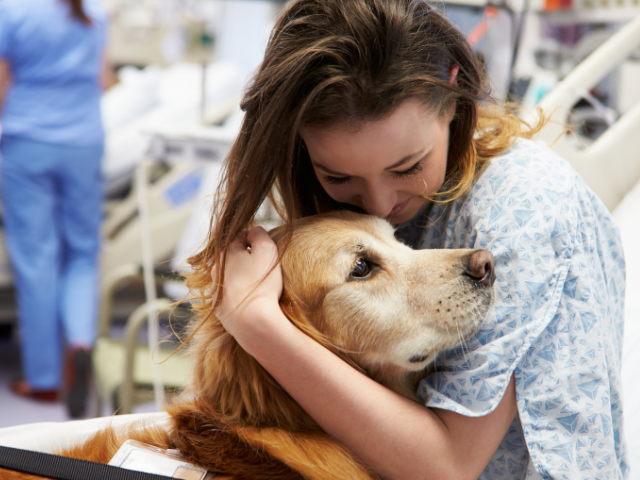The Value of Pet Therapy
Therapists agree that pet therapy has healing powers that assist patients in the hospital setting on their journey to recovery. Animals, large or small, bring comfort to patients, in addition to staff members. Pet therapy encourages the human/animal bond, which many patients enjoy and look forward to. It can assist with physiological health issues, such as lowering blood pressure and improving overall cardiovascular health. But perhaps the most significant impact is on a patient’s mood.
Pet therapy triggers the release of endorphins and dopamine, leading to mood improvement and feelings of happiness. This can help patients forget their suffering, even if just for a short time. Animals have a calming effect on people, and even more so on patients who might experience loneliness and isolation during their hospital stay. They consider the arrival of a pet and its therapist a short respite from whatever put them in the hospital to begin with. These therapy animals can break through the pain a patient may be feeling, providing a much-needed emotional boost.
Becoming a Therapy Pet
Pet therapy can also assist in improving motor skills and movement, encouraging a patient to raise their arm and pet the animal. A small pet makes it a little easier! It can also promote verbal communication with the pet and its trainer, especially for a recovering stroke patient who is having difficulty with speech. Patients undergoing specific chemo treatments enjoy seeing the animals, even from a distance, as it brightens their day and brings a smile.
Therapy teams, such as those at Creature Comfort, which operates in New Jersey, develop a treatment plan and work one-on-one under the direction of a professional therapist. They make regularly scheduled visits to facilities that allow pets to visit patients. The visits are usually about one to one-and-a-half hours long and typically consist of one or two teams. Pets can visit veterans in a hospital who might be experiencing post-traumatic stress disorder (PTSD), schools for Reading to Dogs program, schools for special needs children, rehabilitation centers, adult day programs, or even a local event or conference. They have also been to airports to greet passengers and give some comfort to travelers who might have a fear of flying.
Any breed can be trained to work as a therapy dog, but some are used more often than others. Labradors are a top choice due to their gentle nature and mannerisms. A smaller breed, such a pug or beagle, could be used if a patient is timid around dogs. The dog needs to be trained and certified by a therapy dog organization. The training center will list your dog’s requirements to join the therapy team. The dogs must be in good health, up to date with vaccinations, and have lived with the owner for at least six months. The dogs must be able to accept a friendly stranger and allow petting. They also need to be able to sit or lie down on command and come when called. There are numerous testing classes for dogs and handlers who must be 18 or older.









